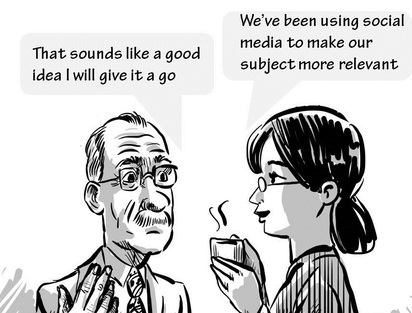
In this blog, I am suggesting that in addition to having frameworks for leadership in higher education we need to open up conversation on what we mean by leadership, how we all conceptualise our role as leaders. I am also suggesting that the deceptively simple 5 practices of good leadership espoused by Jim Kouze and Barry Posner in the 5th Edition of their highly acclaimed book The Leadership Challenge: How to Make Extraordinary Things Happen in Organizations can provide us with a framework for thinking about ourselves as leaders in learning and teaching.
Leadership is currently a hot topic with calls for more or new leadership across all sectors including business, government, public service and administration, and higher education. It almost seems as if leadership is the catch-all for nearly any problem irrespective of context. In the case of Higher Education there is remarkably little research on models or paradigms of leadership in higher education. The studies that stand out are those of MacFarlane (3), and Fullan & Scott (4). A consistent theme in these works is the special and complex nature of leadership in higher education. Co-existing in the same organisations are examples of hierarchical leadership (the norm), distributed leadership by virtue of the compartmentalised nature of higher education institutions with Faculties, departments and administrative centres requiring leaders and leadership that respond to the hierarchy. There will also be many examples of ‘heroic’ individual leadership. What we know very little about is the ‘leadership mindset’ either at individual or collective levels.
Leadership remains a contested concept and despite the vast literature on the topic, there is no magic bullet, no one model of leadership deemed better than another. However, across the terrain of leadership literature and research, much of which is focused on business leaders and leadership, it is clear that the plethora of leadership models and frameworks have a common aim - the ability to influence others to produce positive change that enables an organization or group to achieve its vision (5). But there is perhaps here also a question of whose vision and perhaps the often overlooked role of leader is to engender a spirit of ownership for any vision that is being implemented especially if the vision is being handed down from on high.
The constant call for more or new leadership suggests a perceived gap between what is desired and what is practiced regarding leadership in complex ever changing organisations. What is lacking in much of the leadership literature is an articulation of the vision of what ‘more and new’ leadership is, what it will lead us towards, and what this means for leadership in higher education.
It might be argued that the most appropriate models for leadership of higher education institutions will depend on defining the vision for the institution itself. The institutional mission will reflect the vision and the plethora of functional units will interpret the mission within their particular context.
The five practices of good leadership in Pouze and Kosner’s (6) framework provide us with a tool to reflect on and articulate our leadership practice:
Model the Way – Leaders set an example for all constituents based on a shared understanding of what is expected. Leaders are clear on their values and lead in accordance with these values.
Reflective practice is something of a mantra in higher education. As academics and ‘leaders’ in teaching and learning, reflecting on our values as teachers and how we live up to these values in our practice could be made explicit through our learning and teaching portfolios; our role as role models for learners could be elevated in importance as part of institutional culture.
Inspire a Shared Vision – Good leaders can inspire a vision for the future - 'people commit to causes, not to plans' (6).
The digital and the social age combine to enable new approaches to learning and teaching. Students are stakeholders in the vision for learning and teaching. Why not have learners contribute to the shared vision, shift the dynamics of the classroom, put the ‘social’ back into the act of learning? Design a curriculum for the twenty first century that resonates positively with all stakeholders.
Challenge the Process – The work of leaders is change. All change requires that leaders actively seek ways to make things better, to grow, innovate and improve, to get extraordinary things done (6).
In the 21st century, our constant challenge is rapid and multiple change in almost all spheres of life. There are major global challenges and we need to capture the creative thinking of all stakeholders in the learning and teaching contract. What would a visioning of a curriculum for the social and digital age look like? Can we ask bigger questions of ourselves and challenge our own conceptions of leadership positioning and responsibilities as a leader? Can we constructively challenge the status quo?
Enable Others to Act – Leaders need to consider two essentials: the ability to create a climate of trust; the ability to foster relationships.
Fostering a sense of shared creation of new knowledge and shared responsibility could lead to dynamic learning situations. As outlined in the aforementioned article on the potential of the Flipped Classroom (1), having the courage to let go, to be a learner and teacher simultaneously, creating a climate of trust in the classroom, allows for role modelling the learning process, sharing and creating visions for learning and understanding, engaging with the challenge of a different narrative for higher education and negotiated outcomes for learners.
Encourage the Heart – celebrate the values and victories by creating a spirit of community.
Encourage the heart means remembering to acknowledge, affirm and reward performance, having the generosity of spirit to recognise that success is a shared enterprise.
The most significant function of universities and colleges is to teach, to provide students with the best possible learning experience preparing them for a challenging world. In a changing world being transformed by the capabilities of new technologies and the emergence of the social age, we need to bring to the fore more searching questions regarding our vision for teaching and learning. What is required of us to play a leading role, show leadership and lead the challenge of realising a new vision appropriate to a new age?
The point being emphasised in this contribution to the Lifewide Education blog is that leadership is an active, conscious process. It is so much more than a title, position or mark of status. How often and in what ways do we make explicit our narrative or articulation of our conceptions of leaders, leading, leadership? How do we measure our own effectiveness as leaders?
One final point, leadership is for the many not the few. We tend to think of leaders as those in positions of authority and power but in a world of constant change everyone who is imagining and implementing change be it in the boardroom or the classroom is a leader. So in response to the clarion call for new, better, different or more leadership, we encourage more dialogue and debate within higher education on what it means to be a leader and how we understand ourselves as leaders regardless of our professional role.

 RSS Feed
RSS Feed
